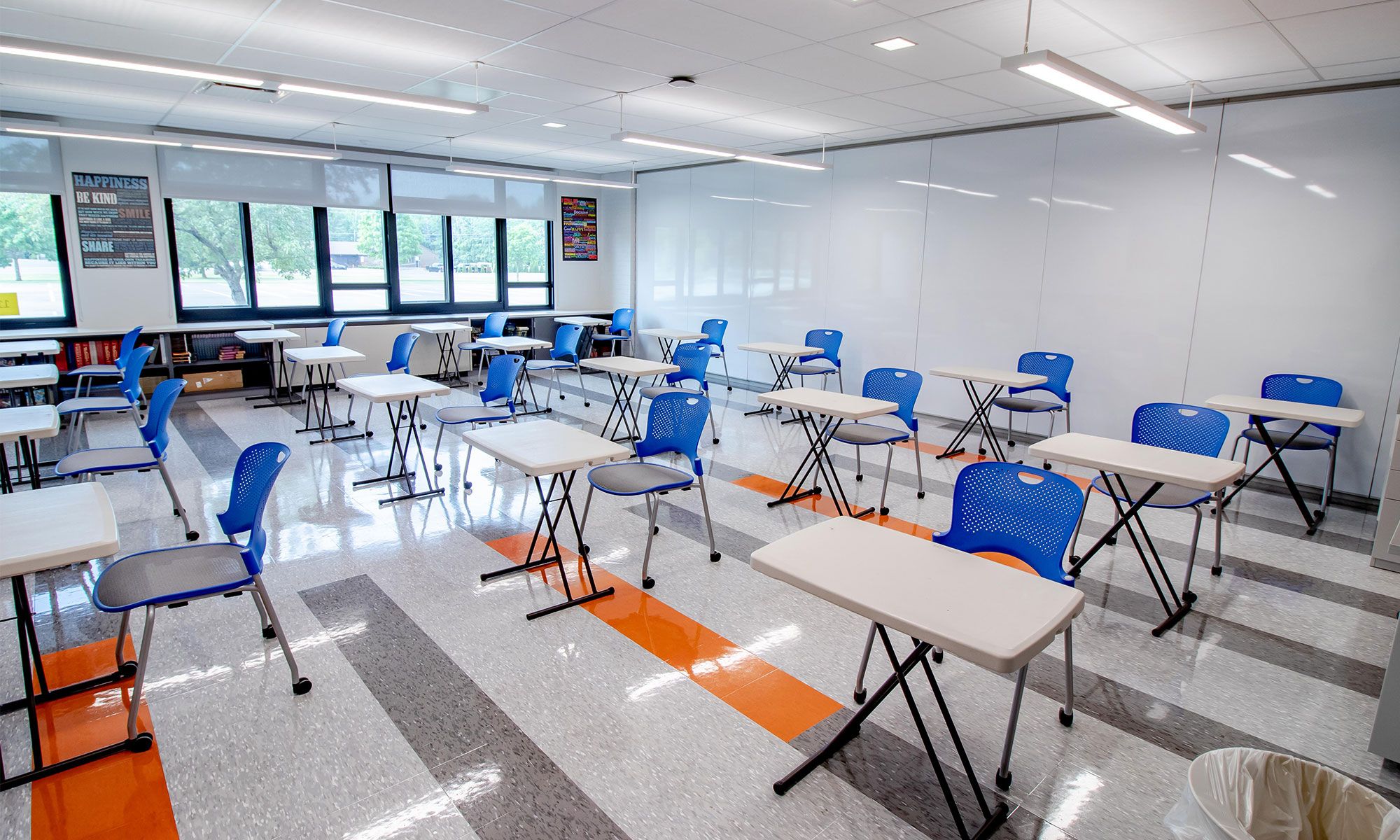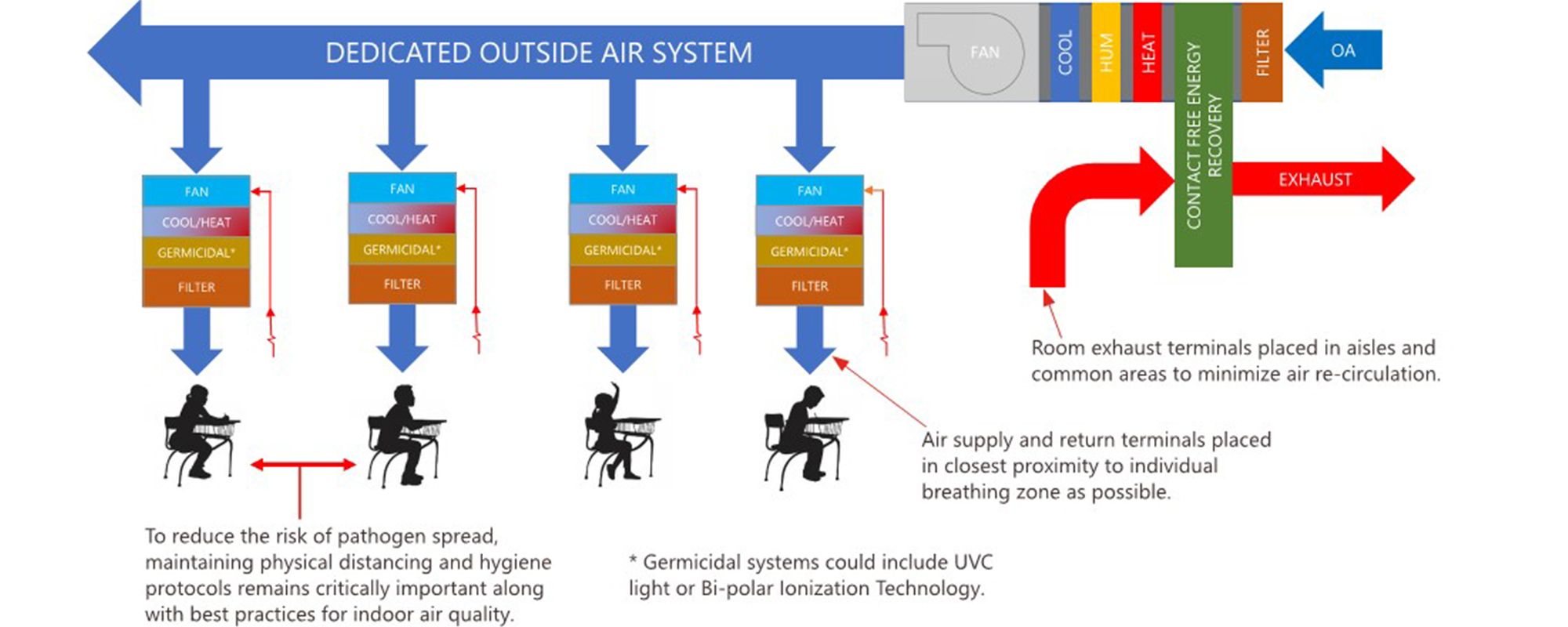Re-Opening in the COVID Era: A Risk-Reduction Guide to Managing Air Quality
Improving indoor air quality is a critical measure building operators can take to ensure safe reopening amidst the coronavirus pandemic.
Re-Opening in the COVID Era: A Risk-Reduction Guide to Managing Air Quality
Improving indoor air quality is a critical item among the menu of measures building operators can take to ensure safe reopening amidst the coronavirus pandemic. Given the likelihood of airborne viral exposure indoors, high-occupancy facilities have to consider changes to their HVAC systems and building operations to minimize the risk of transmission.
While a full ventilation system replacement is an unlikely short-term solution, an evaluation of existing HVAC systems might reveal immediate opportunities for maintenance and interim upgrades. To help reduce the spread of contagions through ventilation systems, we’ve outlined proactive steps facilities teams can take over the next few months, followed by long-term strategies to consider. These measures are applicable to several building types, including K-12 schools, colleges, and offices.
Assess and Maintain Existing HVAC Systems
Facilities operations and maintenance teams should conduct a detailed assessment of existing HVAC systems. At a minimum, this should include checking outside air and exhaust dampers or fans for proper operation and set-points. All systems and equipment should undergo preventative maintenance, including air filter changes, proper filter sealing, as well as any necessary cleaning. Bringing more outside air into buildings is one of the most effective ways to reduce the risk of pathogen spread through recirculated indoor air. A comprehensive engineering analysis can identify to what extent a system’s outside air ventilation rate can be increased without compromising proper filtration, temperature, and humidity control. Engaging a professional engineering consultant may be necessary at this stage and will provide an objective perspective as well as insight into local and industry trends.
Improve System Efficiency Through Retro-Commissioning
Depending on the age of the systems and the level of confidence in their operational parameters, Retro-Commissioning may be recommended as a next step to ensure all systems are performing as intended. Retro-commissioning is a systematic process of investigating, testing, and verifying how systems work individually and together with the goal of identifying operational improvements. The findings will determine if any system needs to be optimized or brought back in line with the original design intent. This process often re-establishes efficiencies, improves occupant comfort, and gains energy savings all while ensuring proper ventilation and environmental controls to improve indoor air quality.
Sufficiently Purge Indoor Air
It is highly recommended to purge buildings at maximum outside air rates for 2 hours prior to and after occupancy. This includes operating exhaust fans as well as opening the outside air dampers. Opening all windows can also serve this function for buildings without the capacity to treat large quantities of outside air and when outside air conditions allow. In addition, operating HVAC systems full-time (24/7) is recommended to maintain continuous air circulation, filtration, and ventilation even during non- occupied hours.

In addition to best practices for maintaining air quality, restructuring classrooms to follow social distancing guidelines can ensure the health and safety of students and faculty.
In parallel with the recommended immediate measures above, long-range planning efforts should critically assess indoor air quality and consider investments in a range of HVAC system upgrades to increase air quality long-term. Taking into consideration the expected remaining useful life of existing systems and the availability of funding, we recommend considering the following long-term HVAC improvements:
Increase Filtration Efficiency
To determine how well your filter captures contaminants, check the MERV rating (Minimum Efficiency Reporting Value), which is the industry standard used to measure the overall effectiveness of air filters. In general, the higher the MERV rating, the more airborne contaminants are filtered.
MERV-13 is currently the minimum recommended filter rating to have any possible impact on capturing virus particles according to ASHRAE. Many HVAC systems found in schools and commercial buildings use lower MERV ratings and are not sized for higher filtration levels. In fact, depending on the design of the system, swapping in a high-efficiency filter may result in an undesirable reduction in airflow due to the additional pressure drop created by higher efficiency filtration. This can be addressed through modifications such as increasing the filter face area, increasing the frequency of filter changes to minimize loading, employing booster fans, or upgrading system fans.
At the high end of available air filtration, High-efficiency particulate air (HEPA) or Ultra Low Particulate Air (ULPA) filters will contribute most significantly to reducing airborne contaminants by filtration and have long been used in cleanrooms utilized for advanced manufacturing, research, and healthcare facilities. These systems are most effective when coupled with unidirectional downflow air distribution creating a piston effect whereby contaminants are pushed past the operational or breathing zone. This will typically require a system of HEPA/ULPA filters, either ducted or fan-powered, to be installed in the ceiling coupled with return air chases extending from the ceiling down to the floor. This type of installation will require careful planning to accommodate required seating and circulation space as well as available floor-to-floor heights. In cases where overhead filter installation is not feasible due to space constraints, floor-mounted filtration systems utilizing flexible ducting can offer a possible solution as well.
Improve Air Distribution
Bringing in more fresh outdoor air by increasing outside air ventilation rates is one of the most effective ways to minimize risk of infectious disease transmission through the air system. Commonly found in research laboratories, 100% Outside Air Systems are ideal, as they do not allow for any potential recirculation of contaminated air from within the building. When sized to meet a building’s full heating and cooling load, 100% Outside Air Systems, however, will result in high energy usage due to the additional heating, cooling, and filtration required to treat the outside air. A full conversion to 100% outside air may therefore not be feasible in many buildings due to high capital and operating costs.
Dedicated Outside Air Systems (DOAS) are a viable option to consider as they deliver only the required ventilation rates to specific building zones. Coupled with local recirculating air systems, these systems allow for limiting the recirculation of air to smaller zones, which can minimize the risk of pathogen spread when paired with proper filtration and air treatment. Consideration to personalized air terminals should be given where possible. Coupled with dedicated fan filter systems, these could be implemented as part of furniture modules or through careful placement of ducting and terminals.
Highly Localized Air Distribution Concept with Dedicated Outside Air Delivery

Control Relative Humidity
The control of relative humidity has been shown to have a significant impact on the viability of viruses in the air. Research has shown that the most unfavorable relative humidity for survival of microorganisms is between 40% and 60%. Maintaining this level of humidity requires active de-humidification in the summer and active humidification in the winter. This can be achieved by retrofitting central air handling systems or duct distribution with humidifiers and dehumidifiers. While these technologies are well understood and readily available, they often require significant retrofits to HVAC systems. Alternatively, local in-room equipment could be considered to control humidity, though these systems will typically not achieve the same effectiveness of distribution and capacity as a central system. Whenever humidification is added to a structure, building envelope conditions should be reviewed for vapor barriers and, in some cases, retrofits may be required to prevent moisture migration into walls.
Explore New Technologies
We’ve discussed increasing ventilation rates and filtration, improving air distribution, and controlling relative humidity as long-term strategies for improving air quality. To validate the investment in these strategies and ensure their effectiveness, we recommend verifying system performance regularly by implementing supplemental automatic sensing and monitoring technologies to confirm flow rates, filter pressure drops, and contaminant levels. In addition to using this data to maintain systems, it can be used as a tool in education and community outreach.
Other technologies for consideration include Ultraviolet (UVC) Irradiation and Bi-Polar Ionization, both of which continue to be studied as a means of reducing the spread of infectious disease through air systems. Additional research is required to validate their efficacy and understand any risks involved. However, these technologies currently look promising and may become part of a longer-term strategy.
These risk-reduction measures to improve indoor air quality represent one layer of defense and are most effective in concert with other strategies such as physical distancing, face masks, and heightened cleaning and hygiene protocols. For more detailed information and strategies on managing indoor air quality, we’ve compiled the below list of articles and resources: